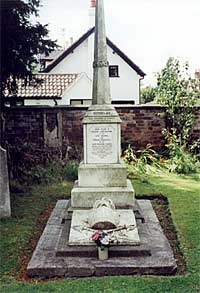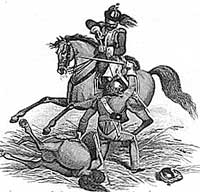
The Waterloo monument in the churchyard (photo: A Nicholson, 2004).
Monday, the 18th of June, 1877, was a day long to be remembered in connection with the history of Cossall. The casual visitor to the village on that day would not be long in perceiving that something unusual was anticipated, for if undisturbed quietness rules anywhere, surely, in a general way, it is at Cossall. Although a place on the whole of a picturesque character, it possesses no special attractions. A farmhouse dotted hero and there; the almshouses, with the old sun dial in front; the school-house, with a bell in its turret; and the ancient church, with the rookery in its rear, are the principal objects with which the eye is familiar : not even a public-house exists to mar the harmony or break the monotony which appear to have become almost essential elements in the lives of its inhabitants, the "Saracen's Head" having long since ceased to scowl upon every passer-by. Cossall was quite en fete on that memorable day, the cause of which was the celebration of the erection of a monument in the neatly-kept churchyard, to the memory of three Waterloo heroes, viz., "Jack" Shaw, Richard Waplington, and Thomas Wheatley. The 18th of June, 1815 (or "Waterloo Day," as it is generally termed) will ever be indissolubly linked with the history of our country, and its anniversary had been most fitly chosen whereon to commemorate those who had left this village to take part in that honourable battle. Although Cossall could not at that time have boasted more than 100 inhabitants, to its honour be it said that it furnished three as brave soldiers as ever fought in a campaign, two of whom gloriously fell on the field of battle, and the other now sleeps in the "God's acre," of his native village. The feats of valour performed by "Shaw, the Life Guardsman," are matters which history records, and a theme upon which many of the good people of Cossall appear never to weary in enlarging.

Life Guardsman fighting with French soldier at Waterloo.
Perhaps it would be as well here to glance briefly at the career of each of these village heroes. Of the three, the place of honour is assigned to Shaw, whose deeds of unparalleled bravery are known in almost every corner of the land. Of his origin and early life, however, little is known. He was born at a farm-house between Cossall and Wollaton in 1789. His father was in pretty good circumstances, and after the birth of our hero, removed to the old manor house adjoining the Churchyard at Cossall, and it was here he first was taught to run alone, and afterwards join in the games of the village boys. When very young he was a delicate lad, and the family doctor told his father that nothing but a liberal supply of new milk would save his life, as he was far out-growing his strength. From this time until John left home, his father set one cow apart for him alone, and the boy used to run to her with a mug as many times a day as he liked; until at last he dispensed with the mug altogether. He went to a school, in company with Richard Waplington, on Trowell Moor, kept by a Mr. Newton: and at the age of thirteen was apprenticed to a joiner and wheelwright at Radford, near Nottingham. The effects of his milk diet were now plainly seen, for he was the tallest and strongest lad of his age for miles around. He was naturally of a pugnacious disposition, and the scrapes he got into with other lads caused words between him and his master, until at last his indentures were given up, and he returned home to Cossall. From this time until he entered the army he worked on Lord Middleton's Wollaton Hall estate, repairing gates and fences, and doing other rough carpentry work, for which he was well adapted, both from his great strength and his partial knowledge of the trade. On the 15th October, 1807, Shaw being then eighteen years of age, six foot in height, with fair complexion, grey eyes, light hair, and round visage, enlisted in the 2nd Life Guards. He was a remarkably large-limbed man, of great muscular strength, being evidently possessed of some education as well as of good character, for he was in due course promoted to the rank of Corporal, a grade which, in the Life Guards, is equivalent to that of Sergeant in other corps. We may here mention that, before he died, he gained half an inch in height. Shaw on joining the Life Guards found himself quite in his element, for pugilism was much cultivated by the Household Cavalry, and very few months had elapsed before he was recognized by his comrades as a bruiser of the first water. Shaw was indeed a formidable novice. He stood upwards of six feet in his stockings, and his weight, when stripped, was fifteen stone, while the dumb-bells and sword exercise had developed the muscles of his arm, and given him a wrist strong and flexible as a bar of steel. But sterner work was yet in store for the gallant Guardsman. Napoleon had escaped from Elba, and all Europe was gathered to crush him once more. Shaw and his comrades of the 2nd Life Guards marched from London to embark for Belgium, and on the 18th of June were present at the memorable battle of Waterloo. Early on the day of the battle, Corporal Shaw was sent in charge of a foraging party. When the first shot was fired about 11 a.m., he was at some distance from the field, but he promptly collected his men, and, hastening back, joined his regiment before the first charge. About 2 p.m., Napoleon's grand attack upon the centre and left of the British army took place, and until nearly nightfall the conflict raged with the utmost fury. Let us see now what part Shaw took in this glorious feat of arms. It is very difficult to ascertain precisely when his fighting came to an end. According to Siborne, Corporal Shaw, after slaying nine of the Cuirassiers in the first charge, was killed by one of his antagonists with a carbine. We are, however inclined to believe that this is a mistake, and that he survived to take part in several later encounters. When his regiment first came in contact with the Cuirassiers, one of the latter awaited the onset, and seemed anxious to challenge him to single combat. Shaw was not the man to decline such an invitation, and rode straight at his opponent. The latter thrust strongly at Shaw below the belt. "Foul," we may imagine the pugilist saying to himself, as he swiftly parried. The next moment the Life Guardsman's sword cut right through the Frenchman's helmet and skull down to the chin, and to use the expression of an eye-witness, the hapless Cuirassier's "face fell off like a bit of apple." Shaw was foremost among his brave comrades the whole day, and is said to have slain a fabulous number of Frenchmen, receiving however, numerous sword-cuts in the course of the fight. When the British cavalry swept away the remains of the French horsemen, Shaw still rode with his comrades. In the melee he found himself isolated, and surrounded by ten of the enemy's horsemen. Whirling his good blade swiftly around, he for a time keeps his foes at bay. At length his sword breaks in his hand; but Shaw will not give in. Hurling the hilt of his now useless weapon from him, he tears his helmet from his head, and tries to use it as a cestus. The Cuirassiers now close in upon him, and the heroic Guardsman is struck to the earth, and they ride off exulting in the thought that they have at length avenged the hecatomb of Frenchmen who have fallen victims to Shaw's slaughtering right hand.. It would appear that after being cut down, Shaw, who had been repeatedly wounded during the day, and had lost much blood, was still able to crawl, and with, as we may imagine, great difficulty and suffering, made his way slowly to the front. Either he was dazed by his injuries, or he was unable to move until the battle had been won, when he instinctively staggered on in the track of the victors. That he must have proceeded towards Charleroi instead of Waterloo is evident from the following circumstance: —A wounded comrade, after being dragged by the French some distance to their rear, was, in the panic which ensued, allowed to sink down on a dunghill near an inn in one of the villages on the Charleroi road, and there he met Shaw. According to Kelley's ' Battle of Waterloo,' the released Life Guardsman was aroused from the stupor into which he had fallen by some one creeping to his side. He feebly turned his head, and beheld Shaw almost cut to pieces, and scarcely able to move, endeavouring to approach him. On recognizing a well-known face, Shaw faintly whispered,—"Ah, my dear fellow, I'm done for." A few words passed between them, but neither was able to say much, and the Life Guardsman who related the story said that he soon fell into the sleep of exhaustion. In the morning he awoke, and found Shaw "lying dead, with his face leaning on his hand, as if he had breathed his last while in a state of insensibility." An eminent continental tourist remarks:—" At La Haye Sainte I was shown the grave of Shaw, the Life-Guardsman, who, with his single arm, is said to have destroyed eight of the enemy. The guide informed me that he saw the body of this brave soldier after death, and was struck with the extraordinary muscular development, and appearance of vast strength, which it displayed. His heart was as big and strong as his body. He rushed headlong into the hostile masses, and woo to the man who had the temerity to measure swords with him." In the battle, although more than once seen engaged hand to hand with two or three of the enemy, he received no wound of any consequence, but appears at length to have fallen from sheer exhaustion, occasioned by his unparalleled achievements, and loss of blood from a number of small wounds. He was several times commanded by his officers to retire from the field, and have his wounds dressed ; but intent only on the performance of what he felt to be his duty, in the peculiar trying circumstances of that day of honour and glory to the British arms, he continued limiting, till he literally bled to death. Thus perished, in the prime of life and the fulness of vigour, one of the most gallant and formidable troopers who ever rode with England's squadrons to battle.
